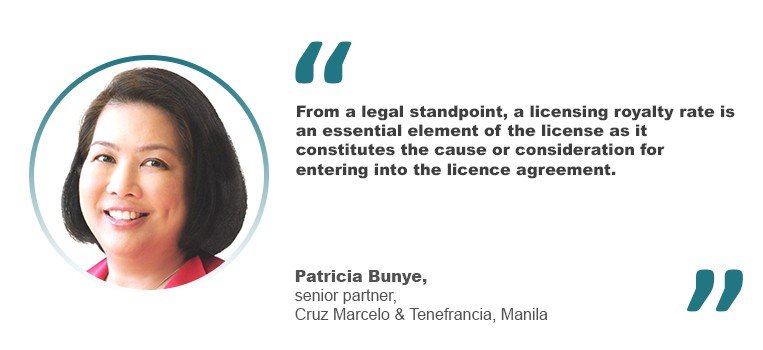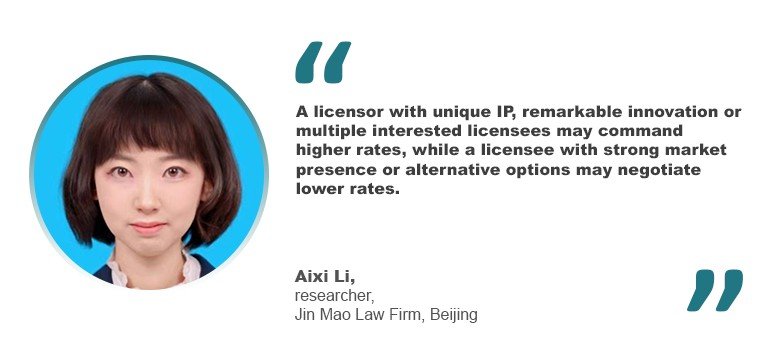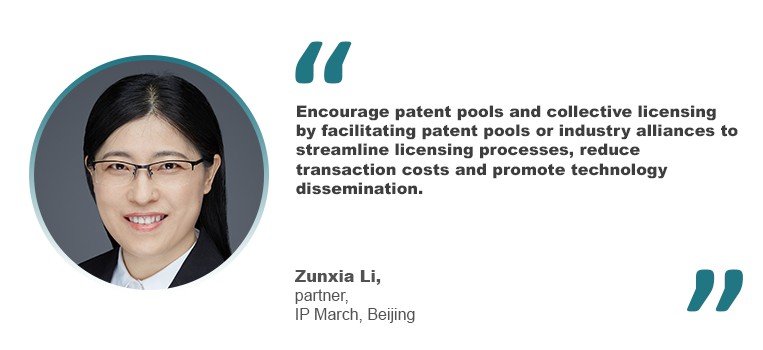More specifically, it depends on the intellectual property asset covered by the licence. “A licensor with unique IP, remarkable innovation or multiple interested licensees may command higher rates,” explained Li, “while a licensee with strong market presence or alternative options may negotiate lower rates.”
For example, if a patent constitutes a core technology embedded in a product such that it is irreplaceable, the royalty rate may be higher. But if the technology is not yet fully developed or may be easily replaced, then the amount must be lower. The ability to drive sales is key.
Exclusive licences also generally yield higher royalty rates as these reduce competition. Research and development (R&D) costs, geographical scope and duration of the licence are also factors in determining the rates.
How do you know if the rate you’re considering is too high or too low?
“Ultimately, what is too high or too low will depend on the subjective assessment of the contracting parties of all the relevant factors, as well as the amount of resources at their disposal,” said Bunye. “A fundamental principle during negotiation in determining the appropriate royalty rate is the need to strike a balance between the licensor’s capacity to profit from the protected asset and the licensee’s potential to receive reasonable returns during commercialization. Setting royalty rates too high may stifle innovation and competition by discouraging potential licensees from commercializing the asset and rendering the licensed products non-competitive. Conversely, setting the royalty rates too low will deprive the licensor of revenue which may harm its financial stability and discourage future innovation.”
Zunxia Li, a partner at IP March in Beijing, said that practices such as bundling unrelated patents and tying arrangements result in excessively high royalty rates in China. Meanwhile, a licensee who intentionally delays negotiations is typically aiming for a low rate. Holding off the talks is the licensee’s way of pressuring the patent holder to give his nod to the rate, despite the fact it’s excessively low to avoid litigation costs. This is just one such instance where unreasonably lower rates are wont to be offered by one party to a licensing contract.
FRAND, technology adoption and innovation
How can licensors and licensees ensure the rates comply with FRAND principles? In the case of patents, how can they ensure the rates are anchored on FRAND terms and, at the same time, make sure the technology is widely accessible and promotes innovation? Here are some strategies to achieve these:
Know industry standards and market conditions. “Conduct market research to understand the benchmark or norm in the market,” said Nont Horayangura, a partner at Baker McKenzie in Bangkok. Analyze market conditions related to IP rights. These include demand, competition, industry standards or trends, potential income generated by the IP and existing regulations in the jurisdiction.
For example, China’s Standards of Copyright License Fee for Copying Musical Works sets out royalty fees for the use of music works to produce recordings in CDs and cassettes based on the formula: wholesale unit price × edition tax rate (6 percent for the first time, 3.5 percent for the other) × the number of recordings. For digital products such as MP3, the royalty is Rmb0.12 (US$0.017) for each piece of music × number of copies.
For book royalties, the country’s Measures for Payment of Remuneration for the Use of Written Works standardizes royalty rates at 3 to 10 percent for original works and 1 to 7 percent for deductive works.
In terms of franchise royalties, the rates are usually at 4 to 12 percent. These rates are generally agreed by both parties as Chinese law has no special provision on franchise royalties, according to Aixi Li.
In the case of patents, she cited the China National Intellectual Property Administration’s (CNIPA) Guidelines for Estimation of Patent Open License Fee (Trial). “[It] proposed that the determination of patent royalty can refer to the same industry or international general licence rate – 25 percent of product profit or 5 percent of product sales – as the negotiation benchmark. In 2021, Chongqing No. 1 Intermediate People’s Court gave a judgment on the case of OPPO v. Nokia’s standard-essential patent royalties dispute and confirmed that Nokia’s 5G SEP portfolios were globally set at 4.341 to 5.273 percent so as to comply with the principle of FRAND,” she related.
Licensors and licensees may also refer to historical licensing agreements involving similar technologies.
Valuable benchmark data may also be gleaned from surveys. For example, the Licensing Executives Society (LES) U.S. and Canada reported that average royalty rates for high-technology fields, such as aerospace, software, communications, semiconductors, electronics and the like, range from 4.8 to 10.7 percent. Similar benchmark data are available for the life sciences sector which covers pharmaceuticals, biotechnology and medical devices. The same applies to the physical sciences sector which includes chemicals, energy, environmental and materials sciences.
All these will serve as reference points for both parties to agree on FRAND-based rates for their licensing contracts.
“Still and all, it does not rule out that higher prices may be worthwhile under special circumstances,” reminded Aixi Li.
Have a value-oriented licensing model. Instead of calculating royalty rates solely as a percentage of the product’s total sales revenue, determine the rates based on value. How valuable is the IP? What are its selling points? What are their advantages? How strong is brand recognition? What is its market position? Is it a frontrunner in the industry? Or does it lag behind the competition?
“The value of the license of a pending patent application is different from the value of the licence of a registered patent,” Bunye pointed out. “There may be scenarios that a pending patent application may not result in the complete grant of the claims relied on by the licensee for its business activities at the time of the negotiation. In other instances, the patent application may not even proceed to grant at all,” she warned. “Thus, it is prudent for the licensee to perform due diligence on the IP subject of the licence grant.”
Being more value oriented will incentivize further innovation.











